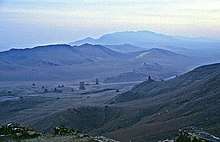Valley of the Tombs
The Valley of the Tombs (Arabic: وادي القبور, romanized: Wādī al-Qubūr) is a necropolis at the west of Palmyra, Syria. It is one of the three necropoleis present around the ancient city. It is one kilometre long (0.62 mi),[1] and easily recognizable by its tower-tombs, among which the former towers of Atenatan, Kitot, Iamblichus and Elahbel where the earliest finds of silk were made[2] and that were destroyed by ISIS in 2015.
 The Valley of the Tombs in 1988 | |
| Location | Palmyra, Syria |
|---|---|
| Coordinates | 34.552418°N 38.257141°E |
Tower-tombs
Tower of Atenatan
As worded by Anna Witecka, "The tower-tomb of Atenatan is the earliest dated tomb in the Palmyrene necropolis. The date of the tower, established by an inscription, is 9 B.C. and the date of the fall of Palmyra in 273 A.D. must be accepted as the terminus ante quem. Built of irregular stones, the tower is quadrangular and narrows toward the top."[3] As described by J. M. C. Toynbee, the tomb "has a facade of limestone blocks and a panelled stone door, composed of two wings that turn on pivots, above which is the slab for a bilingual Greek and Palmyrene inscription."[4]
Tower of Kitot
The Tower of Kitot dated from 40 AD.[5]
Tower of Elahbel
See also
References
- Beattie & Pepper 2001, p. 291.
- Wilson; Bowman (2017). Trade, Commerce, and the State in the Roman World. p. 486. ISBN 9780192507969.
- ANNA WITECKA (1994). "CATALOGUE OF JEWELLERY FOUND IN THE TOWER-TOMB OF ATENATAN AT PALMYRA". Studia Palmyreńskie: 71.
- Toynbee 1996, p. 224
- Henning 2013, p. 162.
- Longfellow, William Pitt Preble (1903). A Cyclopædia of Works of Architecture in Italy, Greece, and the Levant.
Sources
| Wikimedia Commons has media related to Valley of the Tombs. |
- Henning, Agnes (2013). "The Tower Tombs of Palmyra: Chronology, Architecture and Decoration". Studia Palmyrenskie.
- Toynbee, Jocelyn (1996). Death and burial in the Roman World. Baltimore: Johns Hopkins University Press. ISBN 0-8018-5507-1. OCLC 35049546.
- Beattie, Andrew; Pepper, Timothy (2001). The Rough Guide to Syria. Rough Guides. ISBN 978-1-85828-718-8.